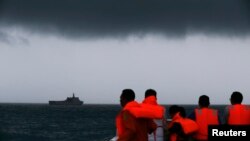Search and recovery teams took advantage of calmer seas Monday to expand the hunt for wreckage and victims of a passenger jet that crashed into the Java Sea eight days ago.
As the recovery effort entered its ninth day, officials intended to send divers down to a large area where five large pieces believed to be that of the downed Airbus A320 have been found.
Bad weather for the last week has hampered efforts to locate most of the 162 people believed to have been killed aboard Flight 8501.
The plane crashed en route from Indonesia to Singapore during a storm, though no official cause has been determined.
Murky waters forced divers to turn back Sunday, after nearing what officials suspect is the main debris field.
“They made the dive but in the sea-bed the visibility was zero which means complete darkness, with muddy sea-bed. Also the current wind is about three to five knots. With this kind of condition, the diving effort is temporary suspended by the coordinator, they will try to use ROVs (Remotely Operated Underwater Vehicle) instead,” said Bambang Soelistyo, head of the National Search and Rescue Agency.
Recovery teams hope to reach what they believe is the plane’s fuselage to retrieve bodies and the aircraft's flight data recorders - the "black boxes" - located in the tail section of the aircraft.
An official from Indonesia's National Search and Rescue Agency said Sunday the fuselage is believed to have broken into several parts, separating the tail from the rest of the aircraft.
"Based on the findings we can say that the plane's body cracked or broke away or separated from its tail, from the side. There is still no confirmation on the exact location. The body was separated from the tail and the black box was located in the area of the plane's tail," said the official.
Nine of the 34 bodies found have been identified.
Indonesia's weather bureau said weather conditions were a factor in causing the plane to plunge into the Java Sea. The findings posted on the agency's website reference several other flights that experienced problems like engine failure and severe turbulence during storms in the area in the last decade.
Before takeoff and during the last moments of the flight, the pilots requested to fly at a higher altitude to avoid a storm. The request was not approved because other planes were in the area.
The twin-engine jet disappeared from radar without a distress call nearly halfway into what was supposed to be a two-hour flight from Surabaya to Singapore.
Indonesian authorities have temporarily suspended AirAsia flights from Surabaya to Singapore because the airline did not have a permit to fly the route on Sundays - the day of the crash.










